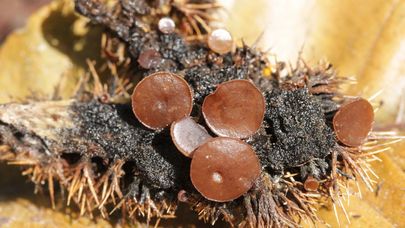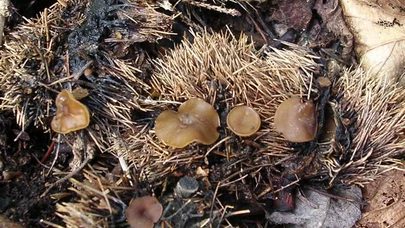Lanzia echinophila
Description
Lanzia echinophila is an inedible (some sources say it's poorly edible) initially subglobose and bright orange mushroom. As it grows it becomes cup-shaped and eventually flattens out, and it's upper (fertile) surface turns reddish brown. Grows on rotting cases of Sweet Chestnuts Castanea sativa, but it can also occur on the cupules of various kinds of acorns, most notably of Turkey Oak Quercus cerris.
This fungus occurs throughout mainland Europe, from Scandinavia right down to the Mediterranean including Germany, France, Spain, Portugal, Austria Italy, and Bulgaria. A very similar ascomycete species was fairly common in parts of North America before a fungal blight killed most of the mature American Chestnut trees Castanea dentata.
Common names: Hairy Nuts Disco.
Mushroom Identification
Fertile Surface
The upper (inside of the cup) surfaces of these cryptic fungi are smooth and vary in color from pale orange through to mid-brown. The cups range from 2 to 10mm in diameter and 1 to 5mm tall. It is attached to a stipe typically 1 to 2mm in diameter and 1 to 4mm tall.
Infertile Surface and Stem
The outer (infertile) surface of the cup is rough and much lighter in color than the inner surface; the spores are produced within asci on the shiny inner surface of the cup.
Asci
Cylindrical; typically 120 x 12µm; amyloid; with eight spores per ascus.
Paraphyses
Narrow, cylindrical. (Paraphyses are structures of sterile tissue between the asci on the hymenial surface.)
Spores
Allantoid (sausage-shaped), 16-20 x 5-6µm, each spore usually containing four oil drops.
Spore Print
White.
Odor and Taste
Not distinctive.
Habitat
Saprobic, mostly on decaying hairy cases of Sweet Chestnuts, but also on rotting acorns, particularly the hairy cases of Turkish Oak fruits.
Season
August to November in Britain and Ireland; later in southern parts of mainland Europe.
Similar Species
Neobulgaria pura produces similar but usually much larger structures on hardwoods, particularly Fagus spp.
History
In 1791 when Jean Baptiste Francois (Pierre) Bulliard described this species, he named it Peziza echinophilus. The currently-accepted scientific name dates from a 1982 publication in Mycotaxon by American mycologist Richard Paul Korf (1925 - 2016).
The specific epithet echinophila means 'spine-loving' and is a reference to the fact that these cup fungi usually occur on the spiny cases of Sweet Chestnuts. The common name also refers to the spiny or hairy outer surfaces of the nut husks upon which this species is found.
Synonyms
Ciboria echinophila (Bull.) Sacc.
Hymenoscyphus echinophilus (Bull.) W.Phillips
Peziza echinophila Bull. (basionyme)
Phialea echinophila (Bull.) Gillet
Phialea echinophila (Bull.) Quél.
Rutstroemia echinophila (Bull.) Höhn.
Rutstroemia echinophila var. corticola Bertault & Malençon
Sclerotinia echinophila (Bull.) Rehm
Photo sources:
Photo 1 - Author: iNaturalist user: bjoerns (CC BY-SA 4.0)
Photo 2 - Author: iNaturalist user: bjoerns (CC BY-SA 4.0)
Photo 3 - Author: Dragonòt (CC BY-SA 3.0)
Photo 4 - Author: iNaturalist user: bjoerns (CC BY-SA 4.0)




